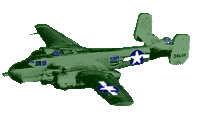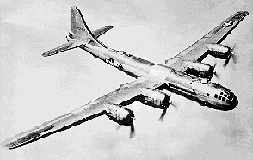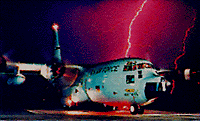| |
Hurricane Hunting started on a dare in the middle of World War
II, when Lt Col Joe Duckworth took an AT-6 Texan training
aircraft into the eye of a hurricane. Our squadron traces its
heritage back over 50 years, to the 3rd Weather Reconnaissance
Squadron, Air Route, Medium on August 7, 1944. From the very
beginning, the squadron began a globe-trotting tradition, with
aircraft spread from Canada to Florida to the Azores.

B-17
FLYING FORTRESS
The Fortress was the most often requested aircraft for weather
reconnaissance in WWII. In Sept. 1945, the 53rd was the first
squadron to intentionally fly a B-17 into a hurricane.
Hurricanes soon became their primary mission, and henceforth the
53rd Weather Reconnaissance Squadron has been known as the
Hurricane Hunters. |
|
 |

The scattering of the squadron's planes around the
globe was required by the very nature of the responsibilities
assigned to the organization. During this early period, the unit
scouted the weather over large geographical areas: remember, this
was in the days before satellites! Day after day, squadron planes
collected data which were transmitted to weather stations for use in
preparing forecasts required for the Air Force and the U.S. Weather
Bureau.

 |
|
WB-25 MITCHELL
A medium bomber, the Mitchell saw more different types of
missions than any other army aircraft in World War II. One such
unusual mission started in 1944, when four B-25s were assigned
to the "Army Hurricane Reconnaissance Unit", a forerunner of
today's Hurricane Hunters. |

In addition to its routine reconnaissance work,
the 53rd also flew many missions to collect data in hurricanes.
It eventually acquired the nickname, "Hurricane Hunters," which
was painted on the unit's aircraft and buildings. Hurricane
missions were flown by the 53rd during the dangerous seasons of
1946 and 1947, and again during the 1951-54 hurricane seasons.
In these post-World War II years, a national plan to collect
hurricane warning information was gradually evolved by the Air
Force, Navy, and the Weather Bureau.
The U.S. Weather Bureau began an
around-the-clock hurricane warning service on June 16, 1947. All
tropical storms and hurricanes were given alphabetical names
(Able, Baker, Charlie, etc.) beginning with the 1947 season for
internal identification in the Weather Bureau. These names were
issued to the public during the 1950-52 hurricane seasons and
were later given the names of women beginning in 1953.
During 1947, the 53rd conducted an experiment (in cooperation
with the Weather Bureau) in which particles of dry ice were
sprayed into the clouds associated with a hurricane. The
experiment was conducted to determine whether the particles
would diminish the intensity of the storm. The results were not
conclusive.
After 1947, the Navy performed reconnaissance in the Caribbean
while the 53rd tracked hurricanes in the West Central Atlantic.
The squadron only survived for a few years in the post-war
drawdown, and was inactivated for nearly three and a half years.
|

WB-29
Superfortress
Weather reconnaissance got a big boost when it inherited surplus
bombers after WWII. This was the Air Force's largest aircraft,
and in 1950, became the first to be designated with a "W" for
weather service. The 53rd scored other "firsts" with the
Superfortress: in 1946, it was the first to fly into the top of
a hurricane, at 22,000 feet (tops of clouds 36,000 feet).
|
|
 |

The squadron came back to life on February 21, 1951, in Bermuda.
After the majority of the squadron moved to Burtonwood AFB, England,
in February, 1954, one flight continued to operate from Bermuda
until May, 1955.
In addition to its normal weather and hurricane reconnaissance
roles, the 53rd remained active with a Christmas tradition that
began in 1953. Since daily flights of the squadron extended to the
far north, children of squadron personnel requested that their
fathers take along letters to Santa Claus. The word of these
deliveries spread and letters from all parts of Great Britain poured
in to the 53rd in 1954. Beginning with the Christmas of 1955,
letters from all parts of Western Europe came to the 53rd for
delivery to Santa.

 |
|
WB-50 SUPERFORTRESS
By 1955, the WB-29s had a lot of
corrosion and were replaced by the WB-50. It looked very similar
to the WB-29, except its 3500-horsepower engines required a
larger tail to stabilize it, so the WB-50 was five feet taller.
It could also fly 850 miles further. The WB-50 had an important
role during the Cuban Missile Crisis, when it |
| monitored the weather around Cuba
to plan photo-reconnaissance flights. Although weather flying
was considered a "peacetime" mission, the aging WB-50s took
their toll, and claimed 66 lives in 13 accidents over their
10-year history in weather. |

The 53rd is no stranger to restructuring and reductions in force.
On March 18, 1960, the Air Force discontinued the squadron for a
year and a half. The nomadic squadron rose again in Kindley Field,
Bermuda, soon moved to Georgia for several years, and then set up
shop in Puerto Rico for seven years.

WB-47
STRATOJET
This was the only jet to fly the hurricane mission, certainly
higher and faster than any aircraft in our inventory. It flew
for 10 years, from 1963-73. However, fast is not necessarily
better in hurricane work; just as you slow down to drive over a
speed bump, aircraft are flown as slow as possible in
turbulence. For that reason, the WB-47 |
|
 |
| could not penetrate the interior
of a hurricane, but skirted the edges of the storm. |

After Hurricane Camille devastated the Gulf Coast in 1969,
congressmen began work to bring the Hurricane Hunters closer to the
Coast. In 1973, the squadron moved to their current home, Keesler
Air Force Base, Mississippi.

 |
|
WC-130
Hercules
The venerable C-130 Hercules first joined weather recce in 1963.
At last, using this sturdy, pressurized aircraft, crews could
penetrate a hurricane without getting soaked by the heavy rain!
The "B" and "E" models of the WC-130 flew many years, and the
"H" model continues to fly today. These "Herks" are now over 30
years old, but have proved to be the most dependable of all the
aircraft in the pages of weather history. |

In 1975, a new contender in the exclusive
"hurricane hunting" mission arrived: the Air Force Reserve! The
815th Weather Reconnaissance Squadron, "Storm Trackers" was born
from a tactical airlift squadron just down the street from the 53rd,
and soon both units were sharing the bulk of the hurricane missions
(with NOAA flying a few of the storms as well). They soon became
well-respected counterparts to the active-duty 53rd.
The 53rd finally succumbed to budget cuts in 1991,
and the Air Force Reserve picked up the entire hurricane hunting
mission. The 815th temporarily became a dual-hatted squadron, and
flew both storm and tactical airlift (cargo) missions. By 1993,
however, the unit split into two squadrons, at which time the
tactical airlift squadron reverted to the 815th TAS Flying Jennies.
The weather squadron resurrected the 53rd Weather Reconnaissance
Squadron, and now proudly carries on the tradition as the Hurricane
Hunters.
Name
3d Weather Recon Sq, Air Route,
Medium
"
"
3d Weather Recon Sq, Air Route,
Heavy
53d Reconnaissance Squadron,
Long Range, Weather
"
"
"
"
"
373d Reconnaissance Sq
Very Long Range Weather
53d Strategic Recon Sq,
Medium, Weather
"
"
"
"
"
53d Weather Recon Squadron
"
"
Discontinued
53d Weather Recon Squadron
"
"
"
"
"
Inactivated
53d Weather Recon Squadron
|
Location
Presque Isle, Maine
Grenier Field, New Hampshire
"
"
"
"
"
"
"
"
Morrison Field, Florida
Camp Kilmer, New Jersey
Kindley Field, Bermuda
"
--
Kindley Field, Bermuda
"
"
"
Burtonwood Aerodrome,
England
"
"
RAF Alconbury, England
RAF Mildenhall, England
--
Kindley Field, Bermuda
Hunter AFB, Georgia
"
Ramey AFB, Puerto Rico
Keesler AFB, MS
"
--
Keesler AFB, MS |
Dates
7 Aug 44
9 Nov 44
12 Jan 45
26 Jan 45
15 Feb 45
--
15 Jun 45
13 Mar 46
20 Mar 46
17 Oct 46
8 Nov 46
23 Jul 47
17 Aug 47
15 Oct 47
--
22 Jan 51
21 Feb 51
2 May 51
20 Apr 53
7 Nov 53
25 Nov 53
8 Feb 54
15 Feb 54
26 Apr 59
10 Aug 59
18 Mar 60
8 Jan 62
31 Aug 63
8 Jul 65
15 Jun 66
1 Jul 73
1 Sep 75
30 Jun 91
1 Nov 93 |
Command
North Atlantic Division
"
Air Transport Command
"
311th Photo-Reconnaissance
Wing, Mapping and Charting
"
Air Transport Command
Air Weather Service
308th Recon Group (Weather)
"
"
"
"
"
"
2108 Air Weather Group
Air Weather Service
9th Weather Group
"
2058th Air Weather Wing
2d Weather Wing
"
"
"
--
9th Wing
"
"
"
"
Aerospace Rescue & Recovery
--
Air Force Reserve |
|